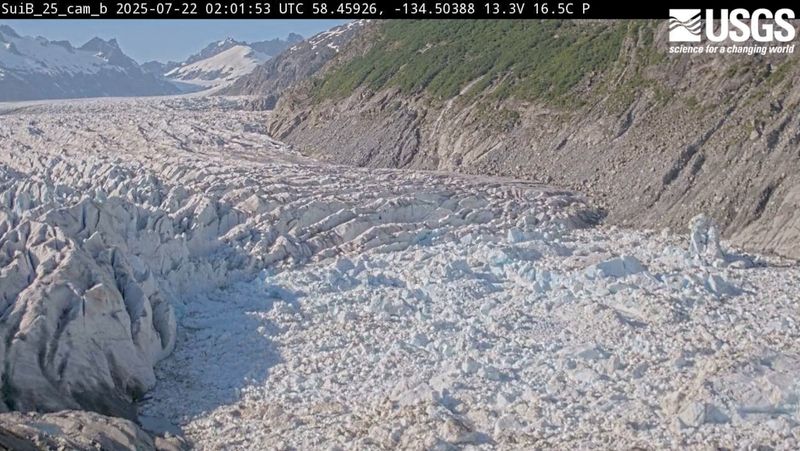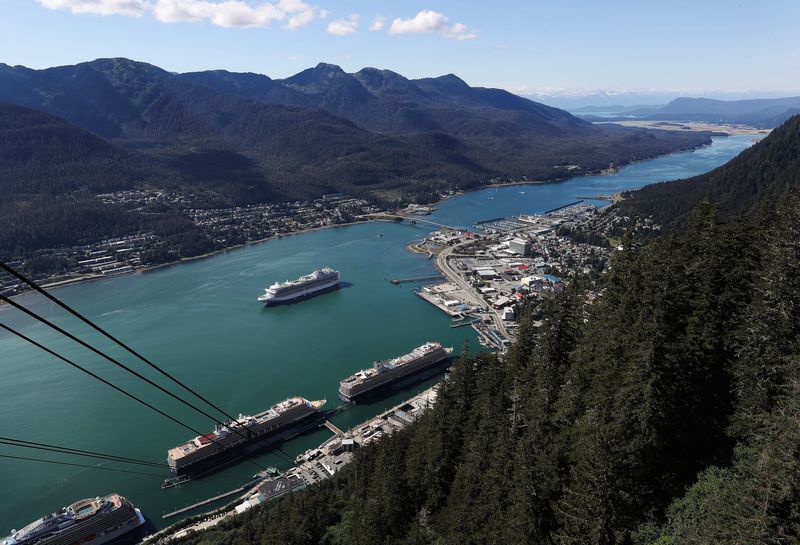


Emergency barriers installed through the Alaska capital city of Juneau appear to have successfully funneled floodwaters away from neighborhoods during a "glacial outburst" supercharged by climate change.
Flooding risk was dropping Aug. 13 after the Mendenhall River crested at a record-setting 16.65 feet deep as of 7:15 a.m. Alaska time (12:15 Eastern), and began to empty out, according to National Weather Service experts. The water level fell down to 15.4 feet an hour after the crest.
"The area will remain in major flood stage area for several more hours," city officials said in a statement. They asked evacuated residents to remain outside the area until notified it's safe to return. Water levels were predicted to drop rapidly following the crest.
Officials said there were reports of "ponding water" in two areas, but it represented minor leaks and not a breach in the Mendenhall Valley neighborhood, where the majority of the city's 32,000 residents live.
"We have crews monitoring the areas closely and will continue to provide updates," city officials said.
Power crews shut off electricity to one area after water surrounded a utility pole; power loss is a significant concern for Alaska residents who often keep chest freezers filled with frozen fish and game.
"Alaska Electric Light and Power will restore power when flood waters have receded, and system equipment is no longer at risk of damage," officials said.
The approximately two miles worth of emergency flood barriers were constructed with the assistance of the U.S. Army Corps of Engineers, whose experts were on scene monitoring. The barriers are a combination of rock-filled steel cages to armor and raise the riverbanks, along with sandbags to stop leaks. The Corps provided materials and technical assistance to build the flood barriers, which were finished last month.
Nahaku McFadden, a Corps spokesperson, said a team of workers quickly repaired a damaged section of the emergency barriers after a tree carried along in the water hit the bank.
"So far, things are looking good but we will continue to provide technical assistance to Juneau, and continue to remain as things progress," McFadden said.
The river has repeatedly flooded portions of Juneau each summer after melting water from the nearby Mendenhall Glacier melts through an ice dam holding back Suicide Basin, sending a deluge downstream. A similar outburst in 2024 that set the previous high-water mark of 15.99 feet flooded basements and damaged roads and other infrastructure.
Gov. Mike Dunleavy had issued a preemptive disaster declaration, citing the devastation caused by two previous outburst-related floods.
Forecasters estimate 14.6 billion gallons of water were released during last year's flood, enough to fill more than 22,000 Olympic-sized swimming pools, according to the weather service.
The flooding has been a growing concern for Juneau over the past several years, and although the barriers were expected to hold back the waters this year, officials had asked some residents to evacuate as a precaution.
Floods in past years have swamped basements, destroyed infrastructure and collapsed buildings near the riverbanks. At least 290 homes were damaged by 2024 floodwaters, displacing residents, Juneau officials said. Some residents became trapped and had to be rescued, Dunleavy said.
A glacial outburst occurs when an ice dam holding back a lake – in this case Suicide Basin – collapses from the summer heat, releasing the water quickly. Suicide Basin is part of the Mendenhall Glacier, a popular tourist destination easily reached from Juneau.
Federal scientists say climate change is causing the glacier to melt faster, along with altering rainfall patterns, exacerbating the danger. The first recorded outburst flood from the glacier happened in 2011, according to the National Weather Service.
Compared with the rest of the country, Alaska has warmed twice as quickly over the past several decades, and its average annual temperature has risen 3.1 degrees in the past century, according to the federal National Centers for Environmental Information.
This article originally appeared on USA TODAY: Alaska capital Juneau dodges flood as emergency barriers contain 'glacial outburst'
Reporting by Trevor Hughes and Jeanine Santucci, USA TODAY / USA TODAY
USA TODAY Network via Reuters Connect

 USA TODAY National
USA TODAY National
 Your Alaska Link Local
Your Alaska Link Local News Radio 690 KTSM
News Radio 690 KTSM The Weather Channel
The Weather Channel Associated Press US News
Associated Press US News Blaze Media
Blaze Media RadarOnline
RadarOnline NBC News
NBC News